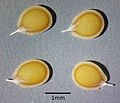Steppe stone herb
| Steppe stone herb | ||||||||||||
|---|---|---|---|---|---|---|---|---|---|---|---|---|

Steppe stone herb ( Alyssum desertorum ) |
||||||||||||
| Systematics | ||||||||||||
|
||||||||||||
| Scientific name | ||||||||||||
| Alyssum desertorum | ||||||||||||
| Stapf |
The steppe stone herb ( Alyssum desertorum ) is a species of the cruciferous family (Brassicaceae). It is particularly widespread in Eastern and Southeastern Europe and in the Middle East.
description
Vegetative characteristics
The steppe stone herb is an annual herbaceous plant and usually reaches heights of 10 to 20 centimeters. On the above-ground parts of the plant there are star hairs which have more than 10 rays in the vegetative area. The leaves are usually 7.5 to 9 times as long as they are wide and have gray hairs. The basal leaves are 2 to 15, up to 30 millimeters long and often have already fallen off at the time of flowering. The stem is provided with simple, undivided and whole-margined stem leaves, which are narrowed or may be missing at the stem base.
Generative characteristics
The terminal, racemose inflorescence has no bracts . The hermaphroditic, radial symmetry flowers are four-fold with a double flower envelope . The four sepals are usually between 1.5 and 1.8 millimeters long and towards the tip with two- to four-pointed star hairs, which are at most 0.7 millimeters long, occupied. At the time of fruiting, the sepals have already fallen off. The four (pale) yellow petals are all the same size and usually between 2.3 and 2.6 millimeters long. The two outer stamens are widened at the base, the four inner ones have an appendage. The stylus is usually between 0.5 and 0.7 millimeters long.
The rounded, flattened pod is bare on the surface. On individuals outside Europe, some fruits have star hairs with adjacent rays. The smooth seeds are egg-shaped with a length of about 1 mm and winged all around.
Chromosome number
The number of chromosomes is 2n = 32.
Phenology and ecology
The blooming time of this therophyte extends in Central Europe from April to May .
The steppe stone herb grows in Central Europe on sandy hills, grass fields and railroad embankments in the colline altitude .
Occurrence and endangerment
The steppe stone herb occurs naturally in Central , Eastern and Southeastern Europe , North Africa , West and Central Asia , Siberia , China , India , Pakistan and in the Caucasus . It is considered naturalized in Finland , Estonia, and Latvia, as well as western Canada and the western and central United States .
In the German-speaking area, the steppe stone herb is only native to Austria . Very rare occurrences are known from the Pannonian region of Lower Austria - in Marchfeld and Steinfeld . In Vienna, where u. a. Occurred frequently on the Türkenschanze in Währing and in Floridsdorf until the beginning of the 20th century, the steppe stone herb has become extinct and is considered to be threatened with extinction throughout Austria.
photos
literature
- Manfred A. Fischer, Karl Oswald, Wolfgang Adler: Excursion flora for Austria, Liechtenstein and South Tyrol . 3rd, improved edition. Province of Upper Austria, Biology Center of the Upper Austrian State Museums, Linz 2008, ISBN 978-3-85474-187-9 , p. 645 .
Individual evidence
- ↑ a b Entry in botany in the picture of the Natural History Museum Vienna (based on the 1st edition of the excursion flora for Austria, South Tyrol and Liechtenstein, the 3rd edition of the excursion flora contains partially changed or different characteristics!)
- ↑ a b c d e f Manfred A. Fischer, Karl Oswald, Wolfgang Adler: Excursion flora for Austria, Liechtenstein and South Tyrol . 3rd, improved edition. Province of Upper Austria, Biology Center of the Upper Austrian State Museums, Linz 2008, ISBN 978-3-85474-187-9 , p. 645 .
- ↑ Alyssum desertorum at Tropicos.org. In: IPCN Chromosome Reports . Missouri Botanical Garden, St. Louis
- ^ Entry in GRIN, United States Department of Agriculture, Agricultural Research Service, Beltsville Area, Germplasm Resources Information Network
- ↑ Wolfgang Adler, Alexander Ch. Mrkvicka (Ed.): The flora of Vienna - yesterday and today. The wild fern and flowering plants in the city of Vienna from the middle of the 19th century to the turn of the millennium , Vienna 2003, p. 373, ISBN 978-3900275969




